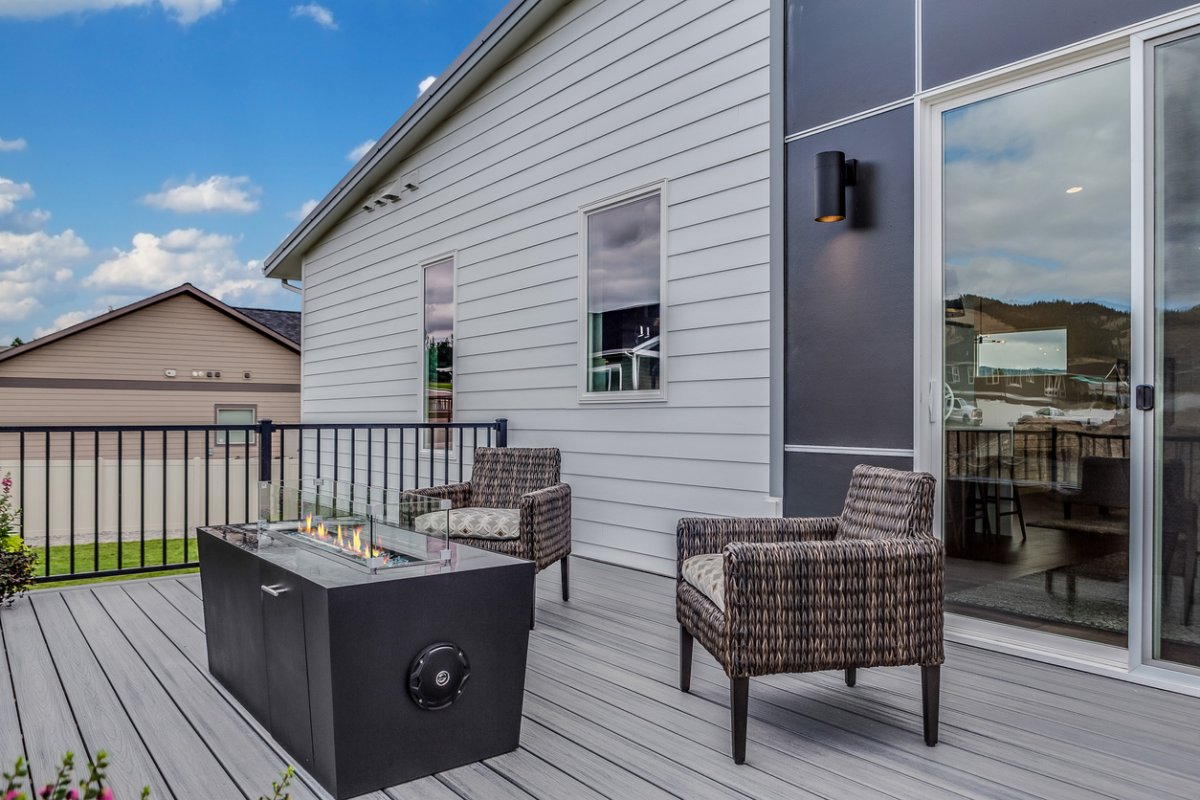

We may earn revenue from the products available on this page and participate in affiliate programs. Learn More ›
The choice between constructing a deck or a patio in a homeowner’s outdoor space often hinges on a variety of factors, not the least of which is the associated cost. Both options provide distinct advantages and design styles, yet their costs can significantly differ due to material choices, the complexity of the installation, and maintenance considerations, among other factors. On average, the cost to build a deck is about $7,900, while a patio can cost approximately $3,800. When considering a patio, homeowners will find that their choice of material influences the overall cost. Concrete is a popular and cost-effective option, with the patio installation process involving excavating, leveling, and pouring the concrete. While a patio generally offers a more predictable cost structure than a deck, the overall expense can still vary based on factors such as patio size and finishing techniques. The cost to build a deck encompasses a range of expenses, such as material selection (which can influence the deck cost per square foot), design complexity, and additional features such as railing systems and built-in seating. If a homeowner is considering a deck replacement, the costs may involve the dismantling of the old deck, proper disposal, and the installation of a new deck structure.
Maintenance is another significant factor in the deck vs. patio cost equation. Over time, both decks and patios may require repairs, but deck repair costs can fluctuate based on the extent of the damage and the materials used. Wooden decks usually need more frequent maintenance and repairs than concrete patios. A backyard deck-patio combo offers the best of both worlds, allowing for a range of outdoor activities. The cost of this combo hinges on the relative sizes of the deck and patio, the materials chosen, and the intricacy of the project’s design. The deck and patio design is important, since a well-conceived plan can help optimize homeowners’ costs with an efficient use of materials and labor.
When homeowners are considering surface options, both patios and decks provide an array of choices. Patio surface ideas include materials such as concrete, pavers, tiles, and natural stone. These selections offer various looks and price points, impacting the overall cost. Deck surface options include treated lumber, composite materials, and premium hardwoods, each with its own maintenance requirements and costs.
In some cases, homeowners may want to replace a deck with a patio. The cost to replace a deck with a patio involves removing the existing deck structure and addressing landscaping changes or drainage considerations. While this change may involve a significant initial cost, it could lead to long-term savings in terms of maintenance and repairs. The choice between a deck and a patio is not solely a matter of design preference; it’s also a matter of cost considerations. Concrete patios offer a more predictable cost structure, while deck costs are influenced by an array of variables, including materials, design complexity, and added features. Ultimately, homeowners are advised to consider their preferences, budget constraints, and their needs and personal preferences regarding the outdoor space. This guide will examine deck vs. patio cost, the influence of chosen materials on the overall project cost, concrete patio maintenance costs, and more.
1. Patios require less labor and materials to build than decks, which usually makes patios the more affordable option.
Patios are often considered to be more cost-effective than decks because patios typically require fewer materials and less labor to construct. The following are a few reasons they tend to be more budget-friendly.
- Materials. Patios are commonly built using materials like concrete, pavers, or gravel, which can be less expensive than the lumber and composite materials often used for decks.
- Labor. Constructing a patio typically involves less complex construction techniques than building a deck, which can require intricate framing and railing installation.
- Site preparation. Building a patio usually involves minimal site preparation compared to that for decks, which often require digging holes and setting footings.
- Permits and regulations. Depending on the geographic location and size of the structure, decks may require more permits and adherence to stricter building codes than patios, leading to additional costs.
- Maintenance. Over time, decks typically require more maintenance than patios. Decks can be susceptible to issues like rot, warping, and fading, while patios made from quality durable materials may have lower maintenance costs.
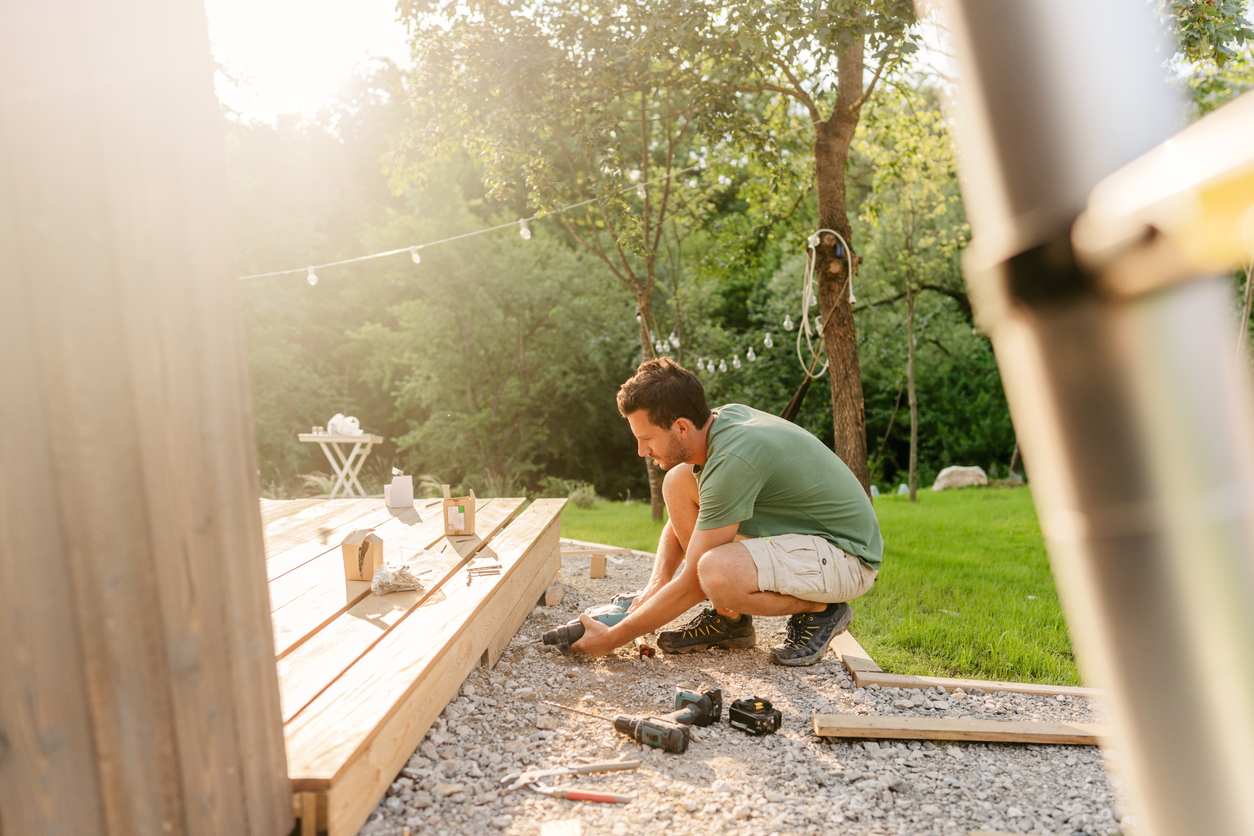
It’s important for homeowners to note that the cost difference between patios and decks can vary based on factors such as the size of the project, the materials used, local labor rates, and any additional features or customizations. Homeowners are advised to gather quotes from contractors and compare the costs and benefits of each option to make an informed decision.
2. The exact cost to build a deck or a patio will depend on the material chosen.
The cost of building a deck or a patio can vary significantly based on material choice, and within each material category, there may be premium options that come at a higher cost. Different materials can impact the cost in the following ways.
- Wood deck. Wood decks are often one of the more budget-friendly options, depending on the type of wood used. The affordability of wood varies based on the wood type. Economical choices such as yellow pine fall at the lower end of the cost spectrum, while wood varieties such as redwood and cedar fall into a moderate price range. Imported wood planks such as Brazilian walnut (also referred to as ipe) significantly raise the overall expense. Pressure-treated wood ranges from $15 to $25 per square foot, redwood runs from $4 to $6 per square foot, and cedar costs from $4 to $9 per square foot. Wood decks require more maintenance over time than other deck materials. Knowing how to waterproof a deck can help homeowners save money on one of the many maintenance tasks.
- Composite deck. When comparing composite decking vs. wood costs, homeowners will find that composite decking is usually more expensive than wood, but it doesn’t need as much maintenance and tends to have a longer lifespan. Composite wood is made from a mixture of wood fibers and plastic, providing a durable and low-maintenance surface. Composite decking material ranges in price from $15 to $36 per square foot.
- Stamped concrete patio. Stamped concrete patios offer a wide range of design options, mimicking the appearance of various other materials, such as stone, brick, and tile. The cost can be higher due to the artistic and labor-intensive process of stamping and coloring the concrete. The cost to stamp a concrete patio ranges from $2,700 to $7,203, with many homeowners spending $4,664, including materials and labor.
- Plain concrete patio. Basic concrete patios are less expensive than stamped or decorative options. The cost can still vary based on the size of the patio and any additional features, such as steps or retaining walls. Concrete patio costs range from $1,760 to $4,812, with the national average at $3,274.
- Stone or paver patio. Natural stone or paver patios can be quite costly, especially if a homeowner uses high-quality or imported materials. Both offer a stunning and durable outdoor space with a variety of design options. The cost of a paver patio ranges from $2,400 to $7,000, while the cost of a flagstone patio runs from $750 to $8,400. The cost of a bluestone patio is between $4,608 and $7,200, with many homeowners paying an average of $6,048.
- Brick patio. Brick patios can also fluctuate in cost depending on the type of bricks used and the complexity of the design. Brick tends to be durable and requires relatively low maintenance.
- Tile patio. Using tiles for a patio can create a unique and attractive outdoor space. Tile prices can differ significantly based on the type of tile and the intricacy of the installation.
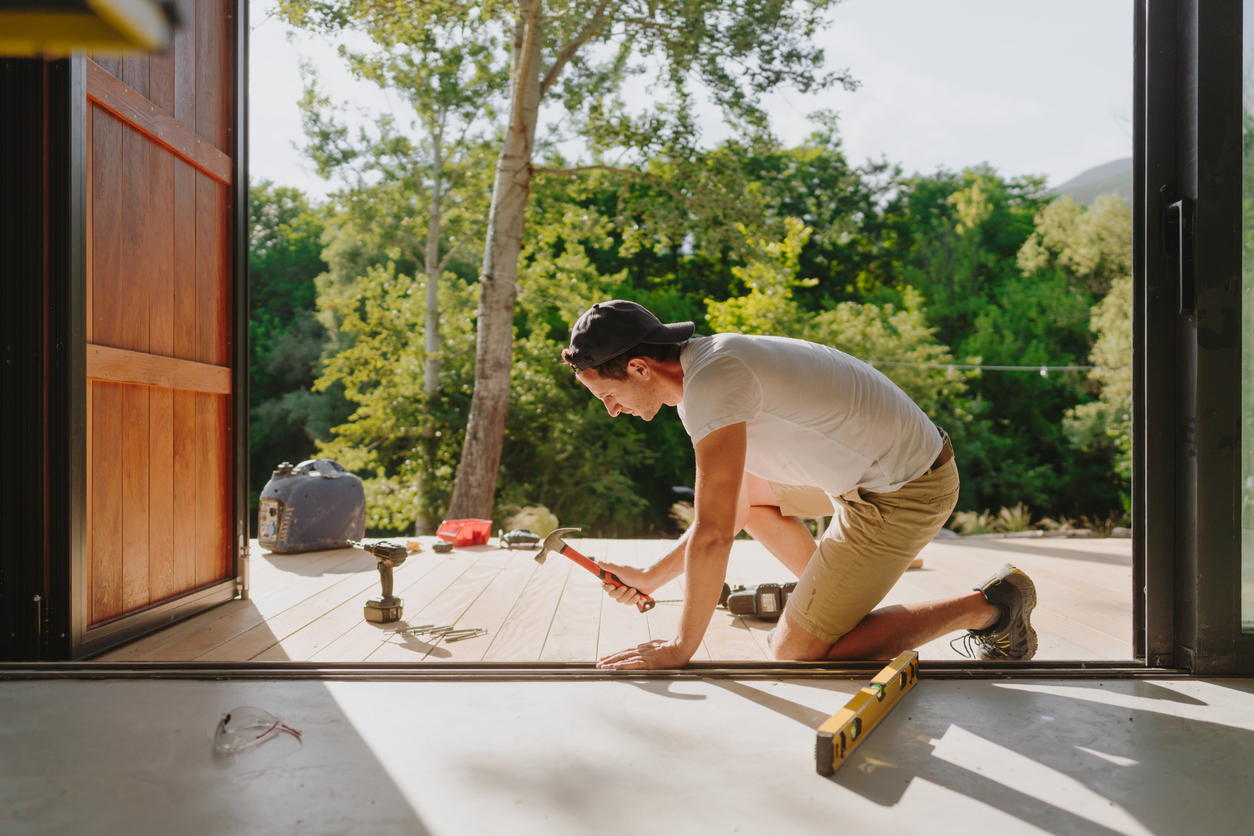
3. Concrete patios require little maintenance, which means fewer costs over time.
Concrete patios are known for their durability and low maintenance requirements, which can lead to cost savings over time. Concrete is a strong and resilient material, capable of withstanding various weather conditions and heavy foot traffic. Regular sweeping and occasional washing with water and mild soap are usually enough to keep a concrete patio clean. Unlike other materials, concrete doesn’t require frequent sealant, stain, or specialized cleaning products. Concrete patios also don’t provide a favorable environment for weeds to grow, and they are less susceptible to pest infestations than wooden decks or other outdoor options. A well-constructed and properly maintained concrete patio can last for decades, reducing the need for frequent repairs or replacements. While plain gray concrete is an option, homeowners can also choose stamped or stained concrete to mimic the look of more expensive materials such as brick, stone, or tile. These designs can add aesthetic appeal without significantly increasing maintenance requirements. When sealed, concrete is resistant to moisture penetration, which reduces the risk of water-related damage. It’s important to note that while concrete patios do require less maintenance than some other decking materials, concrete is not completely maintenance-free. Over time, the material may develop small cracks or wear, and addressing these issues promptly can help prevent more serious issues. Factors like climate, usage, and the quality of the installation can influence the overall maintenance needs of a concrete patio.
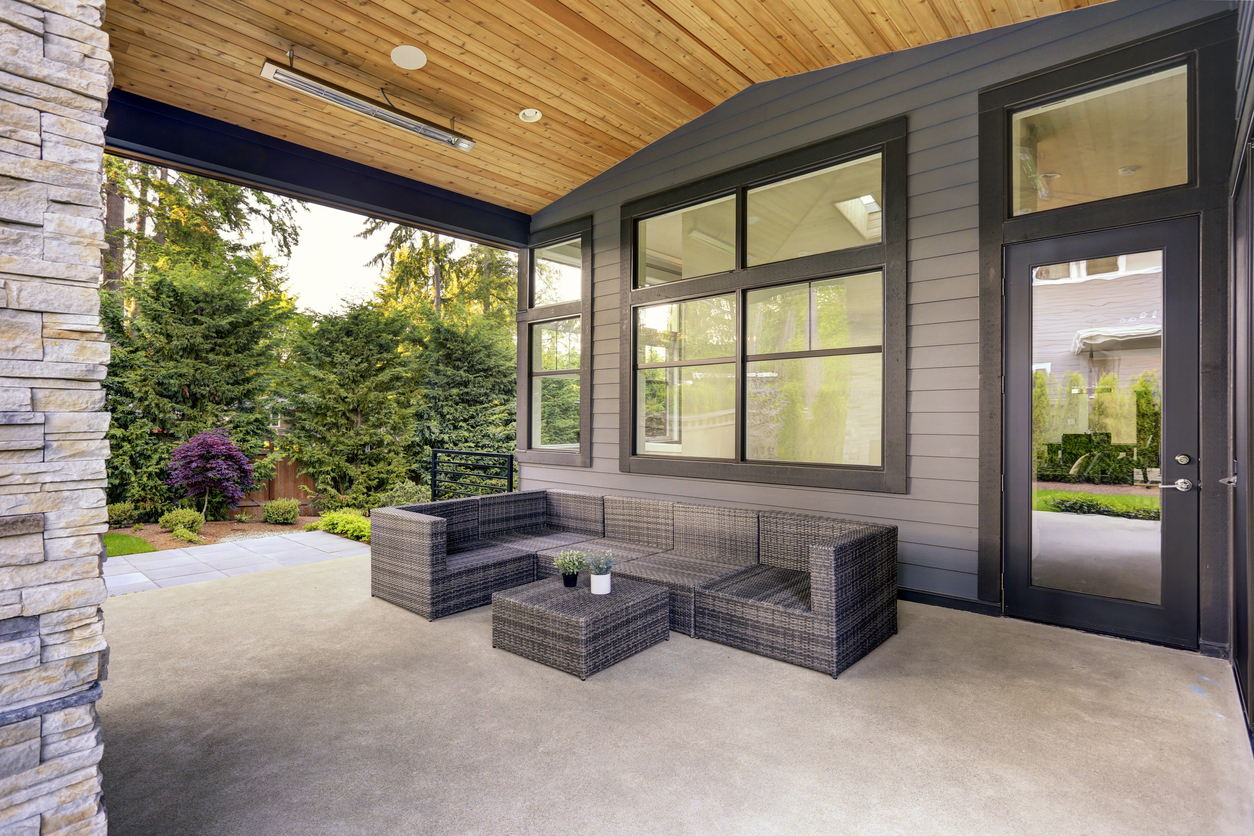
4. Wood decks are cheaper to install than composite decks, but wood requires more regular maintenance, and this drives up the price.
Wood deck costs are generally more affordable than composite decking costs, but it’s important for homeowners to keep in mind that wood decks require more frequent and extensive maintenance, which can increase the overall cost of wood decks over time. While many homeowners appreciate the natural and rustic look of wood, which can enhance the overall appeal of the deck, wood decks require regular maintenance to prevent issues such as warping, cracking, fading, and rotting. Maintenance tasks involve staining, sealing, and performing periodic repairs. The cost to stain a deck ranges from $540 to $1,250, with the national average at $775. While wood decks can have a decent lifespan of 20 years or more with proper maintenance, they rarely last as long as composite decks, especially in harsh weather conditions. Knowing how to restore a weathered deck can help homeowners keep the wood looking like new for longer.
Composite decking, which is made from a combination of wood fibers and plastic materials, is typically more expensive than wood, leading to a higher upfront installation cost, which ranges from $3,600 to $7,800. Composite decks are also known for their low-maintenance nature. They don’t require staining, sealing, or painting, and they are more resistant to issues like rot, insect damage, and fading. Composite decks often have a longer lifespan of up to 50 years; they can withstand the elements better than wood and are less prone to deterioration. Composite materials also offer a consistent appearance and come in a variety of colors and styles. Understanding the differences between wood and composite decks can help homeowners know which material will work the best in an outdoor space.
5. Homeowners will typically need to pay permit and inspection fees to install a deck, whereas they can often install a patio without needing to pay for a permit or inspection.
The need for permits and inspections for deck and patio installations can vary depending on factors such as local building codes, regulations, and the specifics of the project. While it is true that decks often require permits and inspections more frequently than patios, it’s important for homeowners to note that the requirements can differ from one location to another.
Decks generally require a permit and an inspection to ensure the structure is built properly and is not hazardous to those who use it.
- Permits. In many areas, constructing a deck requires obtaining a building permit from the local government. This permit ensures the deck is built to code and meets safety standards. The permit process may involve submitting plans and paying a fee based on the scope of the project.
- Inspections. After the permit is obtained, inspections are typically required at various stages of deck construction. These inspections ensure that the deck’s structural components and safety features, such as railings and stairs, are properly built and compliant with local regulations.

Patios may not require permits and inspections, since they are less likely to be hazardous if installed incorrectly; however, they may be needed in some cases.
- Permits. Since patios are at ground level, they might not always require a building permit. Certain areas may still require permits for more extensive patio installations, particularly if they involve complex features such as retaining walls or drainage systems. It’s recommended that homeowners check their local building codes to determine if a permit is needed.
- Inspections. Patios might not need inspections to the same extent that decks do. If the patio project involves excavating, grading, or altering the landscape, local authorities may require inspections to ensure proper drainage and erosion control.
It’s important for homeowners to research and adhere to local building codes and regulations before starting any construction project, whether it’s a deck, patio, or any other addition to a property. Failing to obtain the necessary permits or meet building requirements can result in legal and financial issues down the road.
6. Patios tend to have a longer lifespan than decks, which means fewer costs for homeowners over time.
It’s generally true that patios have a longer lifespan than decks, resulting in fewer costs for homeowners over time. There are several factors that can contribute to this difference, including the following.
- Material choice. Patios are often constructed using durable materials such as concrete, pavers, natural stone, or bricks. These materials have a longer lifespan and require minimal maintenance compared to wooden decking materials, which are more susceptible to weathering, decay, and insect damage.
- Structural integrity. Decks are usually elevated structures that are exposed to the elements, including rain, snow, ice, sunlight, and temperature fluctuation. Over time, these environmental factors can cause wear and tear on the wood, leading to structural issues that may require repair cost or expensive deck replacement cost.
- Maintenance requirements. Wooden decks need more regular maintenance to ensure their longevity. This includes staining, sealing, and making repairs to address rotting, warping, and splintering. Patios made from durable materials often have lower maintenance requirements, which can translate to fewer ongoing costs for homeowners.
- Cost of repairs and replacement. When decks start to show signs of age, repairs or even complete replacement may be necessary. Patios typically require only minor repairs or touch-ups, which are usually less expensive.

While patios generally have a longer lifespan and lower maintenance requirements, the initial installation costs for decks can sometimes be lower than those for more intricate patio designs. Homeowner preferences and regional factors like climate and weather patterns can influence the decision between building a deck or a patio. When considering the long-term costs and benefits, homeowners will want to evaluate maintenance capabilities, desired aesthetics, and budget before deciding on the best option for their property.
7. Despite having higher costs, decks will typically have a higher return on investment (ROI) than patios, which can benefit the homeowner when it’s time to sell.
Installing either a deck or a patio can enhance the resale value of a home. Numerous prospective home buyers are typically interested in extra outdoor living space when searching for a new residence. Homeowners can anticipate around a 70 percent return on investment (ROI) for a deck installation and a 50 percent ROI for a patio. The potential ROI for a deck or patio project can be influenced by various factors, including the local real estate market, the quality of construction, the overall appeal of the outdoor space, and the preferences of potential buyers. While it’s often said that decks can provide a higher ROI than patios, this may not always hold true in every situation.
8. Homeowners will want to consider their needs and preferences as well as their budget when choosing between installing a patio and installing a deck.
When deciding between installing a patio or a deck, homeowners will want to carefully consider their needs, preferences, and budget to make the best choice for their outdoor space. The following are some considerations for homeowners to take into account regarding patios and decks.
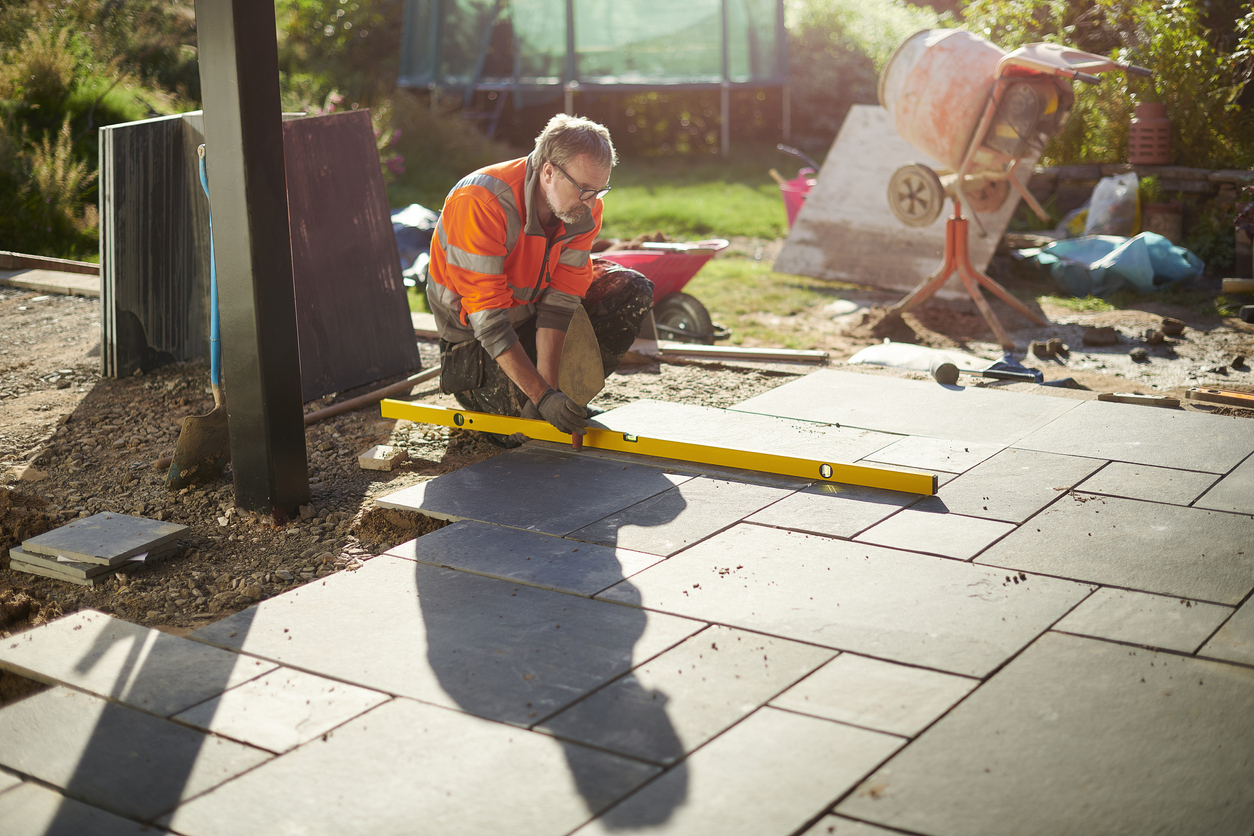
- Patios. Patios are typically constructed on level ground using durable materials. They provide a stable surface for various outdoor activities, such as dining, lounging, and hosting friends and family. They offer a range of design options with various materials, patterns, and colors. They can also be customized to complement the architectural style of the home and can be integrated with landscaping features like gardens and pathways. Patios generally require less maintenance than decks, and depending on the material, patios need only occasional cleaning and sealing to maintain their appearance and prevent cracks. They’re often more cost-effective to install than decks due to the homeowner’s ability to select materials and size based on budget, and they usually require less structural work. Patios are versatile and can be installed on various types of terrain. They can also be designed to incorporate existing landscape features. Patios are more durable in climates with extreme temperature fluctuations since materials like concrete or stone are less prone to expand and contract.
- Decks. Decks are typically elevated structures made of wood or composite materials and are ideal for creating a transition between indoor and outdoor spaces. They provide a natural rustic look if made from wood or a more modern appearance if constructed from composite materials. They can be stained or painted to match the home and the homeowner’s design style. Wooden decks need regular maintenance to protect against fading, insect damage, and rot, and composite decks need occasional cleaning to prevent mold and mildew. Decks can be more expensive due to the additional materials, labor, and the need for a substructure. They are better suited for uneven or sloping terrain, and they can be built to elevate the outdoor space, making them a good option for homes with scenic views or uneven landscapes. Decks can be susceptible to weathering, especially in regions with harsh winter conditions or high humidity.
In the comparison between patios and decks, patios stand out as the more environmentally conscious choice. They are constructed using sturdier materials, which means they do not require replacement as frequently as decks. Decks are crafted from costly raw materials that possess a limited lifespan and can take centuries to regenerate. On the other hand, patios need fewer materials and resources to build, and the materials used tend to be more environmentally friendly.
Ultimately, the decision between a patio and a deck will reflect the homeowner’s lifestyle, preferences, and budget. It’s a good idea for a homeowner to consult with a professional contractor or designer who can provide advice based on the specific needs of the property and the homeowner.
